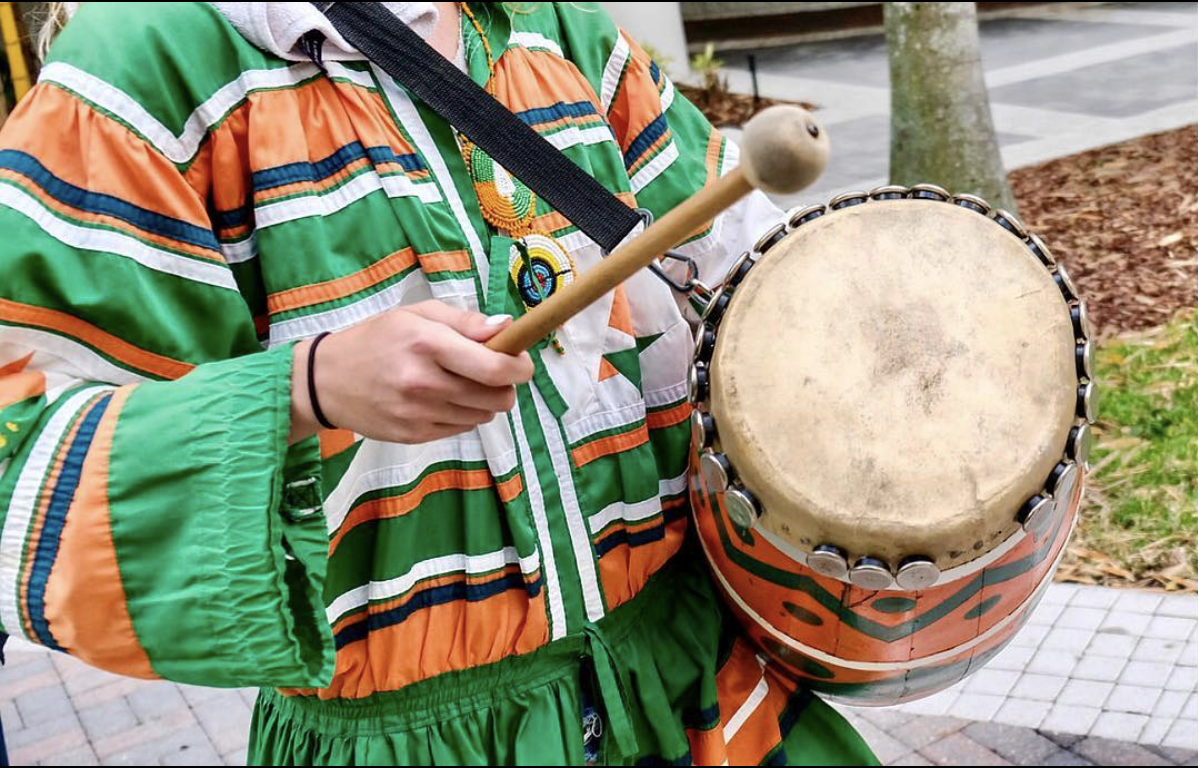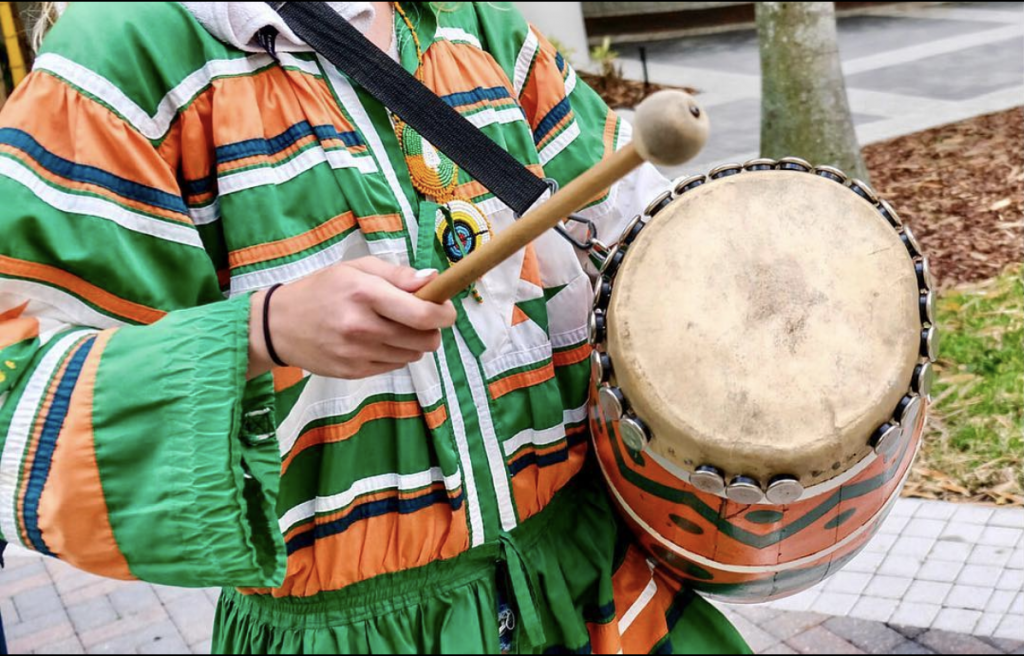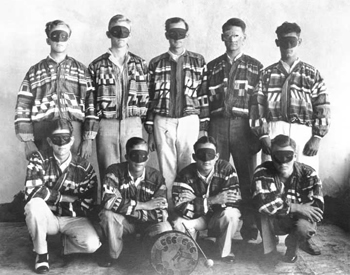

By: Naomi Feinstein and Jesse Lieberman
Iron Arrow Honor Society, which is based on Seminole tradition, faced criticism over its use of sacred Native American traditions by majority-white members that date back to its founding in 1927. However, on Aug. 17, the honor society announced it would be changing key traditions that Native American students and alumni have called highly offensive. This announcement comes as the honor society conducted an internal review of its practices beginning in 2018, which is referred to as a “memorandum of understanding.”
These changes include limiting the use of the ceremonial drum in the tapping ceremony, discontinuing student leadership titles of chief, son of chief and medicine man, as well as the folding of the arms. Previously, the drum would beat all day throughout the tapping ceremonies of new members.
Iron Arrow Honor Society came into existence in 1926 by UM President Bowman Foster Ashe in partnership with the Seminole Tribe as a means to honor high achieving male students. However, in 1976, the honor society was sued in violation of Title IX for prohibiting the admittance of women. The organization then counter-sued in its hopes to continue as a male-only society. President Edward Foote II said Iron Arrow would not be allowed on campus if women continued to be excluded, eventually leading to the society accepting women in 1985.

Years after returning to campus, the Miccosukee Tribe and Seminole Tribe separated, leading to Iron Arrow becoming sanctioned under the Miccosukee Tribe. Through its relationship with these tribes, members have the privilege to wear the colorful, traditional Seminole patchwork jackets and replicate sacred ceremonies of Native American tradition. Prominent members include Grammy-winning singer Gloria Estefan and Rep. Donna Shalala (D-27).
Yet, the incorporation of Native American culture into Iron Arrow has been the center of criticism from former and current Native American students as well as professors within the anthropology department at UM, dating back at least 20 years.
“One of the first days I came on campus I heard a drum beat, and that drumbeat just triggers something in your identity,” said Summer Tiger, who is a member of the Seminole tribe and attended UM in the early 2000s. Tiger then followed the sounds and found an Iron Arrow initiation ceremony.
“I saw their jackets and those jackets are special, when I approached it, I saw a bunch of non-native people. It bothered me,” Tiger said.
After raising her concerns to members of the honor society over its use of Native symbols and explaining the importance of the symbols to her culture, members said Iron Arrow has the permission to use the rituals from the Miccosukee tribe. But, Tiger says that is not enough to excuse themselves from appropriating aspects of her culture.
“I explained the symbols of the drumbeat and the jackets and the defense was they had permission from the tribe,” Tiger said. “You might have permission from one person or the counsel but that doesn’t mean the entire tribe is comfortable with it.”
Students express their concerns over the use of Native American traditions
Thus, in 2002, Tiger with two Native American students, including Meghan Perkins, who is part Cherokee, and faculty hoped to meet with then UM President Shalala over Iron Arrow’s practices and the desire to create Native American Student Association. Yet, Perkins, who graduated in 2003, said Shalala never showed and the student association never came into fruition.
“The consensus in the room was the existence of Iron Arrow was not problematic, but the aspects that were problematic were the aspects of their ceremony that appropriated aspects of very sacred native ritual, such as the use of the drum,” Perkins said. “There was talk of another meeting again and discussing other issues, but it never happened.”
Due to the lack of representation of Native American students on campus, Tiger says they felt powerless in creating real, concrete changes. Both eventually graduated feeling as though nothing was ever going to change regarding their concerns surrounding cultural appropriation. According to UM’s fall 2019 Factbook, there were only 11 Native American undergraduate students.
As the banging drum would permeate throughout campus during Iron Arrow’s biannual tapping ceremonies, anthropology professor Traci Ardren would try to raise awareness surrounding her concern of the use of Native American symbols by predominantly white members.
“Every year, when Iron Arrow is doing its thing on the Rock, I send out an email with links to information about how Native American mascots are a racist tradition. Every year I get serious push back from some administrator or another,” Ardren said. “And while Iron Arrow is not a mascot, it originates in the same impulse — early 20th century notions that Native Americans were “disappearing” like the rest of the wild US .and thus were available to be “saved” by anyone who wanted to dress up or live out the fantasy of being non-white.”
Additionally, Morgan Owens, who was inducted into the honor society spring of 2018, says he along with other members would tell the officers how he felt uncomfortable with specific aspects of the honor society and its use of Native American symbols, specifically the war paint and Seminole patchwork.
“It feels like I’m wearing something that has a whole lot of meaning and I don’t know what the meaning is supposed to be,” Owens said. “I don’t know why I have been given this jacket…other than that someone may have thought it looked nice.”

Therefore, Owens said during his time in Iron Arrow, he felt members were not equipped to explain the meaning behind the symbols they were using within the honor society.
“It’s great that they partner with the Miccosukee tribe, but the Miccosukee tribe can’t give permission to everyone at UM to act like a Seminole or act like a generic caricature of a Native American,” Owens said. “That sounds harsh, but that’s how it looks to people when you are just walking through campus.”
He brought his concerns to the leaders, but nothing could be agreed upon and the structure of only appointing upperclassmen, he says, hinders the ability to create change as members are only in Iron Arrow as undergraduates for about a year.
Newly appointed leader forges change for the honor society
But, with these concerns in mind under newly appointed leader Cachay Byrd, Iron Arrow Honor Society announced it will discontinue traditions Native American students found to be offensive and not necessary. This announcement comes after Iron Arrow last year met with Allison and Sarah Cawthon, two Native students at UM who expressed concerns and anger about what they deemed “cultural appropriation.” The Native students declined to comment for this article.
“It was first and foremost to ensure our students understood that we understand. We heard them and their comments did not go unheard or unanswered,” Byrd said. “Being part of an organization that wouldn’t do the world to ensure people feel comfortable, makes me uncomfortable— I’m all about diversity equity and inclusion.”
The process began in 2018 after Iron Arrow appointed then student and Miccosukee tribe member Curtis Osceola to serve as a liaison for the society. Osceola had led a panel at UM discussing elements of cultural appropriation. He spoke to a number of indigenous students from FIU and UM, he said he realized that some students may be offended by some of the society’s practices.
“The main objection was that ‘why do people who get rewarded for doing good get to mimic Native Americans?’ So from my perspective, we said they could have these sacred ceremonies. It’s not like they are parodying, these are actual ceremonies,” Osceola said. “They are an extension of us to the UM community, but it did highlight that perspective is not shared by all.”
With approval from leaders of the Miccosukee tribe, Osceola worked directly with Iron Arrow’s members and leaders to better understand the importance and significance behind the practices they were gifted many years ago. Osceola noted the purity of the original gifts had eroded.
“The tribe saw this and said, ‘yeah we need to listen to our brothers and sisters from other tribes, and we should of course be sensitive to their understanding and beliefs,” he said. “We shouldn’t trample on them because we see things a certain way.”
This is a monumental moment in Iron Arrow’s history as many of its practices have remained the same since its founding. Osceola credits the young leadership of the organization in questioning some of its practices and creating substantive steps in the right direction of this partnership.
“It was really the young leadership who took it upon themselves to look in the mirror and ask ‘what are we doing and why are we doing it,” Osceola said.
The influence of the Black Lives Matter movement
With the Black Lives Matter movement at the forefront of society over the past few months, professional teams that use Native American names and mascots, including the Washington Redskins, began a process of self-reflection to eliminate years old caricatures of different minorities. Similarly, the movement has influenced how Iron Arrow acted. Byrd, a person of color, approached the criticisms intently.
“As a Black woman I would hate to come to a university where I felt like my culture was being mocked,” said Byrd, who was part of a group of Iron Arrow members that met with the Native American students who had criticisms of Iron Arrow. “I completely understood where they were coming from.”
With the rise in social justice protests across the country in the wake of George Floyd’s murder, many organizations and corporations released statements in support of the protests, including many around UM. As this unfolded, Iron Arrow remained quiet, even as Byrd was inundated with emails asking when they would release a statement,
“I was like, Iron Arrow can’t say anything right now,” Byrd said. “All I could think about was being a Black woman, the leader of an organization that stands at the forefront, saying we are a group of individuals that hold the highest honor at a university, and yet there are things that we have the power to fix that we haven’t fixed.”
Although the discussion had been ongoing within Iron Arrow for a couple of years, Byrd says the outside world helped push them towards making a change.
“It’s not to say that these things would never be fixed, but I think it took outside influence to kinda work and make things make sense,” Byrd said.
Another misgiving that Byrd hopes to address during her time as chair is Iron Arrow’s lack of presence around campus in everyday life.
“Most honor societies around colleges are more prominent than us,” Byrd said. “One person came to me and said, ‘you guys just appear and then disappear.’’
Iron Arrow hopes to become open to the greater UM community
For years, Iron Arrow has built a reputation for being shrouded in secrecy. Be it what goes on in their initiation ceremonies (which members decline to discuss) or simply what they do. And like many organizations that steep themselves in secrecy tend to be, rumors started to run rampant about them. But, Byrd feels with more education and openness that will change.
“I don’t want ‘what is this organization doing’ to be a question anymore,” Byrd said. In order to achieve this, Byrd is making sure Iron Arrow sponsors more school functions and has an open door policy. “I hope people will be more comfortable with asking questions, and as an organization, we will try to do more to be present and educate people.”
The education doesn’t just extend to outsiders, Byrd wants Iron Arrow members to be fully integrated into the culture they are sharing. This is done through conversations with council elders and attending events on the reservation, all of which are open to the public.
Through Iron Arrow, Osceola explained, the tribe hopes to gain a foothold within the UM and greater Miami-Dade communities, becoming a model of cultural exchange for others.
“The tribe also wanted to express that we want to be understood so the tribe made a plea to others who don’t understand the relationship to try to understand it,” he said. “We view the Iron Arrow and its memberships as ambassadors for our tribe as they learn about us and our identity. We are so few; only 600 of us and we can only do so much.”
As the Native American population struggles with high unemployment and poverty rates, there is hope that the relationship between the tribe and university could serve as an avenue to admit and educate more Native American students.
“The motivation is trying to get kids exposed to an environment so they don’t feel alienated when they go to college,” Osceola said. “It is a very different environment than being on the reservation.”
One of the ways Iron Arrow is hoping to do this is by welcoming Miccosukee youth onto UM’s campus for a day when class is in session. During the annual Miccosukee Day, Iron Arrow members would host high-school students from the tribe and take them through a typical day at UM. Both the youth and Iron Arrow members felt the day was rewarding.
“It was really cool,” Byrd said of the event. The students came to campus dressed in their school uniforms and got to see the hospital in the medical school and other places around campus. “It was fun to talk to someone closer to your age and learn about their culture.”
Although no one can say what Iron Arrow will look like in the future, Byrd hopes it will be known as an organization that recognizes achievements from those in the UM community and cherishes and learns about the history of the Miccosukee tribe.
“How can you be an honor society if no one respects you?,” Byrd asked. “The announcement won’t be the end of the work we do; I want to bring forward the misgivings of the organization and address it publicly.”





